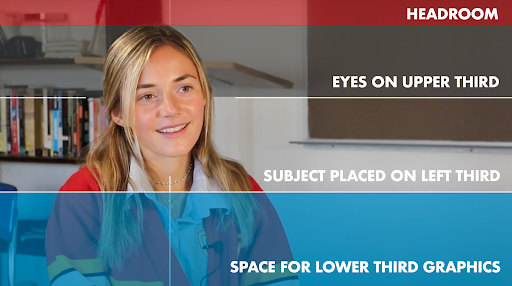Look at the image below. Typically, video journalists frame their interview subjects to follow the rule of thirds. When composing a shot for most types of recorded interviews, imagine there’s a Tic-Tac-Toe grid over the screen. Make sure the main action, or the subject's eye, is positioned at one of the intersecting points. Typically the subject looks at the interviewer NOT at the camera. You can also flip the side of the frame for stories with multiple interviews.

**There are times when you can consider having your subject look directly to the camera during interviews. It's an evolving editorial and production question. Is your interview subject sharing their opinion with the intention of speaking directly to an audience, versus the reporter for the piece? Also consider, unless the audience has a "host" to the story, a reporter/correspondent, they don't know who the person is talking to, so it might make more sense to talk to the audience directly.
Civics teaches the principles—such as adherence to the social contract, consent of the governed, limited government, legitimate authority, federalism, and separation of powers—that are meant to guide official institutions such as legislatures, courts, and government agencies. (NCSS D2.Civ.7.9-12 - D2.Civ.10.9-12)
Students leverage technology to take an active role in choosing, achieving and demonstrating competency in their learning goals, informed by the learning sciences. (ISTE)
Students communicate clearly and express themselves creatively for a variety of purposes using the platforms, tools, styles, formats and digital media appropriate to their goals. (ISTE)
Journalism
Video Production
Lessons
Beginner
Camera or Mobile Phone
Notebook
15 Minutes